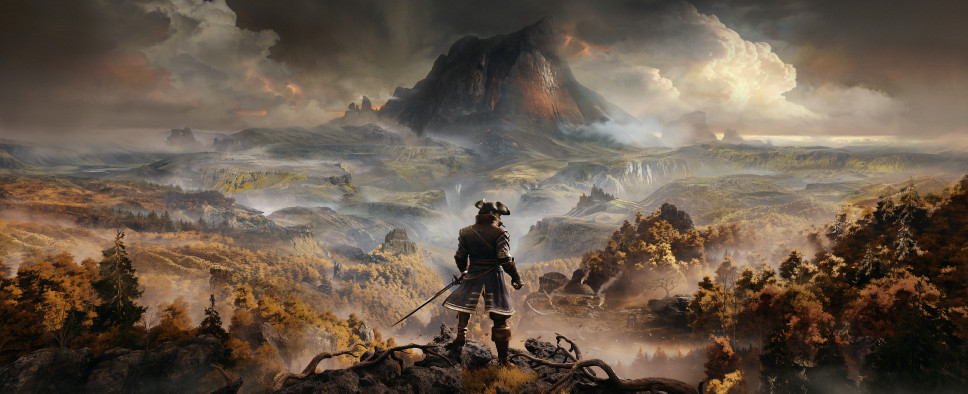GreedFall Review
-
Category: ReviewsHits: 12866

Article Index
In fact, "learning everything" is a problem with the character system. I like systems where there are lots of possible builds, and you have to make significant choices as you level up. But that's not the case in Greedfall. I earned way more skill points than I needed, and I was able to max out all of the talents that I cared about. That left only attributes where I had to make decisions for my build, and I don't think those decisions were overly meaningful. And so while I liked how the character system gives you lots of options for how to play the game, I wish it didn't allow every character to use every option. Choices are good.
Along with your main character, there are also five companions -- one for each of the game's factions outside the Congregation of Merchants, where your character is the representative. The companions level up and improve themselves automatically, so you're not given any choices for how to build them. But the companions follow five different fighting styles, and so it's easy to pick two (the most you can have with you at once) to complement your playing style. I picked Siora the healing native and Kurt the heavy weapons guard in my game.
Interface
Greedfall is played using a third-person perspective. You only control your main character, even when you have companions with you. You're not even allowed to give your companions helpful orders like "move over there" or "prioritize your gun over your sword" or "stay away from the boss creature when it telegraphs its big melee attack." You just have to hope that they do something useful, which, nicely, they usually do.
The interface is about what you'd expect for the PC version of the game. You move around using the WASD keys, you attack with the left mouse button, you block with the right mouse button, and you trigger spells, potions, and your gun with the 1-0 keys. However, there are also a multitude of other keys -- Q for a fury attack (a "critical hit" that you power up during combat), the control key for a secondary attack (an attack associated with your weapon, like "kick" for light weapons), the shift key for dodge, C for stealth, E for interact, the middle mouse button for targeting (otherwise the game picks the "best" target for you), and the spacebar for tactical pause.
I usually do better with games that require fewer keys -- especially when the shifts, controls and alts start coming into play -- but I eventually got competent enough at Greedfall, mostly because it let me reconfigure the keys to a way that made more sense to me (such as moving stealth to the control key, where it seems to be in every other game I play). Since every key can be reconfigured, it also means you shouldn't have any trouble playing Greedfall, even if you're left-handed.
Combat in Greedfall seems to owe a lot to The Witcher 3: Wild Hunt, or at least the same basic attack strategies work for both games. That is, you're going to have to learn how to parry and counterattack, or attack and dodge away, depending on the opponent. The main difference in the combat engines is Greedfall's gun. You can't use your gun all the time (it can't be assigned as your main weapon, and you're limited by the number of bullets you have available), but you can beat all of the enemies -- and especially the bosses -- by staying away from them and shooting them when it's safe.
Unfortunately, another difference between the engines is that Greedfall's is a bit clunkier. Actions like dodging aren't as fluid, and you're not allowed to cast spells or quaff potions while you're moving. Instead, you have to stand still for about five seconds while the animation plays out -- which is usually a good way to get killed.
When you're not in combat, items you can interact with -- like chests, corpses, and plants -- glow invitingly. Oddly, that makes it easier to explore when it's dark because then all of the important spots are much more apparent. Meanwhile, NPCs don't glow, but they get an icon over their head if they have things to say, equipment to sell, or a quest to give. There are also quest markers for every part of every quest, and they always show you exactly where to go (and there isn't any way to turn them off).
Campaign
The vast majority of Greedfall takes place on Teer Fradee, the newly-discovered island where you hope to find a cure for the plague ravaging your lands. There are six factions on the island: your nation, the Congregation of Merchants; two ally nations (one dominated by religion and the other dominated by science, so of course they're at war with each other); the Coin Guards, who provide security for everybody; the Nauts, who provide shipping and transportation for everybody; and the natives.
Your goal on the island is to look for a cure, but that's not really the focus of the campaign. Instead, as the legate (aka deputy) of the Congregation governor, you're often tasked with settling disputes. Most of these disputes involve colonists killing / torturing / robbing the natives, and unfortunately they only play one note. The colonists are always in the wrong, and there's never any gray area where you could maybe see their point of view. For example, at one point the religious faction decides to torture natives until they see the light and revoke their old gods. So do you look the other way and support your ally, or do you rescue the natives? I played as a "paladin" during the campaign, and I always sided with the natives, and yet at the end all of the factions loved me, which was disappointing.

